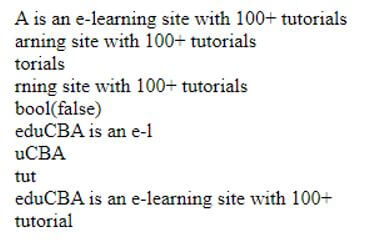Updated April 18, 2023

Introduction to PHP substr
PHP substr is a built-in function of PHP used to extract the specified part of a string. Substr() is a function used to cut a part of a string starting from a specific position to a particular length. In cases where the trimmed string is empty or any failure occurs, substr() will return false. PHP version 4 and above supports the substr() function. A string is among the data types PHP supports; these string variables contain alphanumeric values. String methods can manipulate these strings; one among them is substr().
Syntax
Given below is the syntax mentioned:
substr(string_name, starting_position_of_string, string_length_to_cut);Parameters:
Substr() allows 3 arguments or parameters in which 2 are mandatory, and the other is an optional parameter.
- string_name: String parameter which needs to be modified. It is the mandatory parameter to be passed and specifies a string to be one or more characters.
- starting_position_of_string: It is also the mandatory parameter to be passed to the substr() method. It refers to the position of the input string from where part of the string needs to be cut. The parameter’s data type is an integer; hence, the integer can be positive, negative, or even 0.
- Positive number: If the length of the specified string is a non-negative integer, a returning string will start from a specified position of the input string.
- Negative number: If the length of the specified string is a negative integer, a returning string will start from a specified position from the end of the string.
- 0: If the length of the specified string is 0, it will start at the first character of the input string.
- string_length_to_cut: This parameter is optional and of integer type. It refers to the length of the string returned from the input string or, to put in t\other words, the length of the string that needs to be cut from an input string.
- If length is positive, it refers to the start position and extracts length from the beginning of the string.
- If length is negative, it refers to the start position and extracts length from the end of the input string.
- If this parameter is not passed, then substr() will return the string starting at the start_position_of_string till the end.
- Substr() if successful returns extracted part of the string, then returns false or failure or an empty string.
Examples of PHP substr()
Take an input string and apply the substr() method to get the specified portion of the string. Let us see some of the examples:
Example #1
PHP substr() with no specific length.
Code:
<!DOCTYPE html>
<html>
<body>
<?php
echo substr("This is the first example of a PHP substr()",13);
?>
</body>
</html>Output:
Example #2
PHP substr() with negative starting position.
Code:
<!DOCTYPE html>
<html>
<body>
<?php
echo substr("This is the first example of a PHP substr()",-15);
?>
</body>
</html>Output:
Example #3
PHP substr() when length is 0.
Code:
<!DOCTYPE html>
<html>
<body>
<?php
echo substr("eduCBA is an e-learning site with 100+ tutorials", 14, 0). "</br>";
?>
</body>
</html>Example #4
PHP substr() with negative length, negative starting position.
Code:
<!DOCTYPE html>
<html>
<body>
<?php
echo substr('PHP substr() returns a part of string', 5, 19);
echo '<br>';
echo substr('PHP substr() returns a part of string', -5, 3);
echo '<br>';
echo substr('PHP substr() returns a part of string',-18, -2);
?>
</body>
</html>Output:
Here, ‘echo substr(‘PHP substr() returns a part of a string,’ -5, 3);’, -5 refers to the start of the input from the end of the string. 3 refers to returned strings cutting length.
Example #5
Code:
<!DOCTYPE html>
<html>
<body>
<?php
$sample_string="eduCBA is an e-learning site with 100+ tutorials";
echo $sample_string;
echo '<br>';
echo substr($sample_string,-10);
echo '<br>';
echo substr($sample_string,-4, 3);
echo '<br>';
echo substr($sample_string,5,-4);
?>
</body>
</html>Output:
Example #6
Code:
<!DOCTYPE html>
<html>
<body>
<?php
var_dump(substr('eduCBA is an e-learning site with 100+ tutorials', 100));
?>
</body>
</html>Output:
Example #7
Code:
<!DOCTYPE html>
<html>
<body>
<?php
echo substr("eduCBA is an e-learning site with 100+ tutorials", 5);
echo '<br>';
echo substr("eduCBA is an e-learning site with 100+ tutorials", 17);
echo '<br>';
echo substr("eduCBA is an e-learning site with 100+ tutorials", -7);
echo '<br>';
echo substr("eduCBA is an e-learning site with 100+ tutorials", -30);
echo '<br>';
var_dump(substr("eduCBA is an e-learning site with 100+ tutorials", 100));
echo '<br>';
echo substr("eduCBA is an e-learning site with 100+ tutorials", 0, 16);
echo '<br>';
echo substr("eduCBA is an e-learning site with 100+ tutorials", 2, 5);
echo '<br>';
echo substr("eduCBA is an e-learning site with 100+ tutorials", -10, 4);
echo '<br>';
echo substr("eduCBA is an e-learning site with 100+ tutorials", 0, -10);
echo '<br>';
echo substr("eduCBA is an e-learning site with 100+ tutorials", -9, -1);
?>
</body>
</html>Output:
Conclusion
With this, we conclude ‘PHP substr.’ Introduced to what PHP substr is and its syntax. How do the Parameters work in the syntax? Listed out a good number of examples to work on. We have mentioned the starting point to extract the input string. A starting point can be positive or negative; a negative starting point is extracting the input string from the end. The optional parameter ‘length’ can also be positive or negative or nothing. If the input string length is less than the length specified or no length is specified, substr() returns Boolean false.
Recommended Articles
This is a guide to PHP substr. Here we have discussed the introduction, syntax, and examples of PHP substr() along with code implementation and output. You may also have a look at the following articles to learn more –






